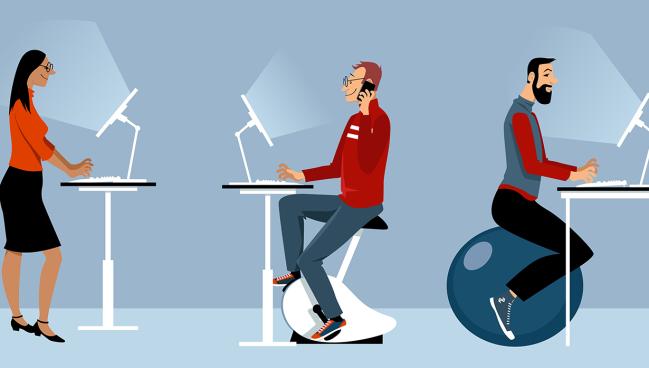Standing Alone Will Not Offset Sitting’s CVD Risks, Study Suggests
In addition to avoiding too much sitting, moving around is critical to ensuring good cardiovascular health, one researcher says.

Spending more time on one’s feet—if it’s not accompanied by some type of activity—does not appear to be sufficient to lower the risk of cardiovascular disease, and in fact it may lead to some harm, according to an analysis of the UK Biobank.
The risk of orthostatic circulatory disease, including orthostatic hypotension, varicose veins, chronic venous insufficiency, and venous ulcers, was greater with increasing standing time beyond 2 hours each day, researchers led by Matthew Ahmadi, PhD (Charles Perkins Centre, University of Sydney, Camperdown, Australia), report.
The study, published online recently in the International Journal of Epidemiology, also confirmed that sitting more than 10 hours per day was associated with heightened risks of both major cardiovascular and orthostatic circulatory diseases.
“Everyone pretty much is very well aware that sitting is not good for your health—the more you sit, the higher your risk of heart disease is,” Ahmadi told TCTMD. “However, the health effects of standing are a little less clear. And that's primarily because the research on standing has been done around cardiometabolic markers, such as insulin sensitivity, hypertension, or triglyceride levels.”
This study helps fill some gaps in knowledge by examining the impact of standing time on adverse clinical outcomes and provides results that align with prior studies of office workers “that found standing is better than sitting, but the optimum mix for health is combining standing with other forms of activity that get the body moving,” he said, adding that “in order to improve cardiovascular health, you have to engage the cardiovascular system.”
Day-to-Day Activities Can Help
Ahmadi and his colleagues examined data on 83,013 adults (mean age 61.3 years; 55.6% women) included in the UK Biobank who were free from orthostatic circulatory disease and major CVD at baseline. Times spent sitting, standing, or stationary (a combination of sitting and standing) were measured using wrist-worn accelerometers. The investigators assessed clinical outcomes over a mean follow-up of 6.9 years.
Mean times spent sitting, standing, and stationary were 12.8, 2.1, and 10.7 hours per day, respectively.
Standing time above the reference level of 2 hours per day was not associated with risk of major CVD (coronary heart disease, heart failure, or stroke). Each additional hour of stationary time beyond 12 hours per day, however, was associated with a 13% greater relative risk, and each additional hour of sitting beyond 10 hours per day was associated with a 15% greater relative risk. Stationary and sitting times below those thresholds correlated with lower major CVD risks.
“Collectively, the implications of our findings for public health messaging are supportive of current messages encouraging sitting reductions for CVD health,” the authors write. “However, they do not support increasing standing time alone as a mitigation strategy cited in some guidelines.”
Standing is better than sitting, but the optimum mix for health is combining standing with other forms of activity that get the body moving. Matthew Ahmadi
In contrast to major CVD risk, the risk of orthostatic circulatory disease was greater when any of the three exposures—stationary, sitting, or standing times—exceeded the reference thresholds. Risk was increased by a relative 11% for each additional 30 minutes of standing beyond 2 hours per day and by a relative 22% and 26% for each excess hour of stationary or sitting time, respectively.
The investigators note that “the nonlinear associations we detected suggest that up to a certain level, neither sitting nor standing are harmful for orthostatic conditions, suggesting that there may be a healthy balance between these two behaviors. This balance likely varies among individuals, depending on comorbidities, overall health status, and daily physical activity levels.”
The findings are consistent with a prior analysis by Ahmadi’s group indicating that incorporating even a few thousand steps into one’s day can help offset the cardiovascular harms of sitting too much.
“Standing is certainly better than sitting, . . . but standing should be mixed with other forms of activity that gets you moving,” Ahmadi said.
And that doesn’t necessarily mean formal exercise time each day. “There's been other research being done that shows just day-to-day activities can also improve your health,” he said. “And that's really important, I think, for people, especially middle aged-to-older adults, who might be time poor and don't have the time to go spend an hour or half an hour at the gym every day. They can also get the same health benefits just by doing day-to-day activities like gardening, household chores, or taking a walk around the block.”
Todd Neale is the Associate News Editor for TCTMD and a Senior Medical Journalist. He got his start in journalism at …
Read Full BioSources
Ahmadi MN, Coenen P, Straker L, Stamatakis E. Device-measured stationary behaviour and cardiovascular and orthostatic circulatory disease incidence. Int J Epidemiol. 2024;53(6):dyae136.
Disclosures
- Ahmadi reports being funded by the National Heart Foundation.





Comments